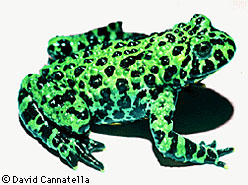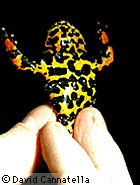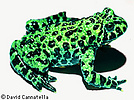Bombinatoridae
Bombinas and barbourulas
David Cannatella- Bombina
- Barbourula
Introduction
This family includes only two genera, Barbourula and Bombina. Barbourula occurs in the Philippine Islands (Barbourula busuangensis) and Borneo (Barbourula kalimantanensis). The approximately six species of Bombina are found in Europe, the western soviet republics, western Asia, China, Vietnam, and Korea.
Bombina are warty, aquatic toads, and tend to be gregarious. The vocal behavior of some Bombina is unusual in that the call is produced during inhalation rather than exhalation as in other frogs. They lay pigmented eggs in ponds. The tadpoles have beaks, two upper and three lower rows of denticles, and a median spiracle (typical Orton Type 3).
Species of Bombina have bright red or yellow mottling on the venter. The German word Unke means toad. Bombina exhibit an "unken reflex" when bothered. The animal will arch its back and limbs to expose the bright belly, and may turn over on its back. This acts as a warning to predators. Not surprisingly, the skin toxins of Bombina are distasteful.
Barbourula are not as brightly colored but have webbed fingers in addition to webbed toes. Tadpoles of Barbourula are unknown. Both genera have flattened bodies.
Fossil Bombina are known from the Pliocene to the Pleistocene; there are no fossils of Barbourula.
Discussion of Phylogenetic Relationships
In most classifications, Bombina and Barbourula have generally been placed in the Discoglossidae. Cannatella (1985) presented a phylogenetic analysis that indicated the Discoglossidae was paraphyletic. Synapomorphies of Discoglossanura (Ford and Cannatella, 1993) reject the monophyly of "Discoglossidae" as traditionally used. Ford and Cannatella (1993) formalized this by resurrecting the family Bombinatoridae for Barbourula and Bombina. They considered Bombinatoridae to be the node-based name for the most recent common ancestor of Bombina and Barbourula, and all its descendants. Synapomorphies of Bombinatoridae are an expanded flange of the quadratojugal and the presence of endochondral ossifications in the hyoid plate; these are not parahyoid bones, which are also present (Cannatella, 1985; Clarke, 1987).
Almost all workers have placed Alytes, Discoglossus, Bombina, and Barbourula in Discoglossidae, although the dissimilarity of Alytes and Discoglossus, on one hand, and Bombina on the other has often been noted (e.g., Lanza et al., 1976). In contrast, the recent study of Hay et al. (1995) found Bombina orientalis and Discoglossus pictus to be closest relatives; this supports the traditional arrangement of the Discoglossidae.
Griffiths (1963) stated that the diagnostic feature of "Discoglossidae" (including Bombinatoridae and Discoglossidae) is a triradiate sternum. However, this type of sternum is also present in Leiopelma, and is a synapomorphy of Leiopelmatanura.
References
Click here for general list of references
Title Illustrations
| Scientific Name | Bombina orientalis |
|---|---|
| Copyright | © 1995 David Cannatella |
| Scientific Name | Bombina orientalis |
|---|---|
| View | ventral |
| Copyright | © 1995 David Cannatella |
About This Page
If you are interested in authoring or co-authoring the page for this taxon, or some part of it (even a species), contact David Cannatella.
David Cannatella
Section of Integrative Biology and Texas Memorial Museum, University of Texas, Austin, TX 78712
Correspondence regarding this page should be directed to David Cannatella at
Page copyright © 1995 David Cannatella
Citing this page:
Cannatella, David. 1995. Bombinatoridae. Bombinas and barbourulas. Version 01 January 1995 (under construction). http://tolweb.org/Bombinatoridae/16971/1995.01.01 in The Tree of Life Web Project, http://tolweb.org/










